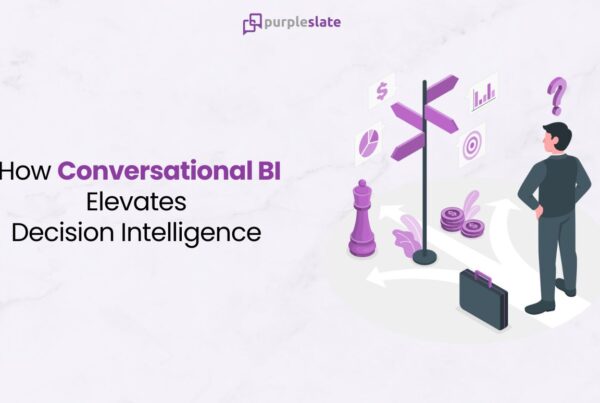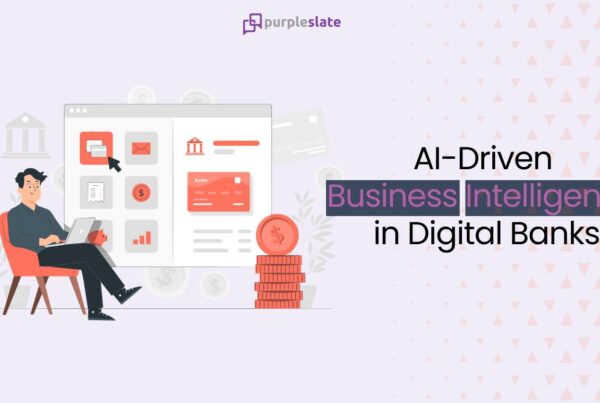
Introduction
Businesses are flooded with enormous amounts of data generated from diverse sources in today’s data-driven world. To make sense of this data and leverage it for strategic decision-making, companies rely on Business Intelligence (BI) tools. These tools have been instrumental in transforming raw data into actionable insights, enabling organizations to stay competitive and make informed decisions.
Traditional BI tools typically involve data warehousing, reporting, and basic analytics. However, the landscape of BI is rapidly evolving. Advanced BI tools, powered by cutting-edge technologies such as artificial intelligence (AI) and machine learning, are redefining how businesses interact with and interpret their data. These tools offer enhanced capabilities, including real-time data processing, and natural language processing (NLP), making data analysis more intuitive and accessible than ever before.
The objective of this blog is to delve into the realm of advanced BI tools and explore how they can uncover hidden business opportunities. By understanding the capabilities and benefits of these tools, businesses can unlock new avenues for growth, improve operational efficiency, and gain a competitive edge in the market. We will also highlight a specific tool, Kea, and its role in revolutionizing the way businesses harness the power of their data through conversational insights.
Understanding Advanced BI Tools
Advanced Business Intelligence (BI) tools represent a significant evolution in the field of data analytics, offering enhanced capabilities and functionalities compared to traditional BI solutions. Here’s a breakdown of what constitutes advanced BI tools and their key components:
Definition and Components
Advanced BI tools are sophisticated software platforms designed to analyze and interpret vast amounts of data to provide actionable insights to businesses. These tools typically consist of several key components:
- Data Integration: Advanced BI tools are capable of integrating data from multiple sources, including databases, spreadsheets, cloud platforms, and streaming sources. This ensures that businesses have a comprehensive view of their data landscape, enabling more informed decision-making.
- Data Analysis: Once data is integrated, advanced BI tools employ various analytical techniques to uncover patterns, trends, and correlations within the data. This includes descriptive analytics to summarize historical data, predictive analytics to forecast future trends, and prescriptive analytics to recommend actions based on insights.
- Data Visualization: Advanced BI tools utilize data visualization techniques to present insights in an intuitive and easily understandable format. This includes interactive dashboards, charts, graphs, and heatmaps that allow users to explore data visually and gain deeper insights.
Evolution from Traditional BI to Advanced BI Tools
The evolution from traditional BI to advanced BI tools has been driven by advancements in technology and the changing needs of businesses. Traditional BI solutions were primarily focused on basic reporting and querying functionalities, often requiring IT expertise to extract insights from data.
In contrast, advanced BI tools leverage technologies such as artificial intelligence (AI) and machine learning to automate data analysis processes and provide more accurate and timely insights. These tools also offer real-time data processing capabilities, allowing businesses to make decisions based on the most up-to-date information.
Key Features of Advanced BI Tools
- AI Integration: Advanced BI tools incorporate AI algorithms to automate repetitive tasks, such as data cleansing and modeling, and to uncover hidden patterns and trends within the data.
- Machine Learning: Machine learning algorithms enable advanced BI tools to learn from past data and make predictions about future trends, helping businesses anticipate market changes and make proactive decisions.
- Real-Time Data Processing: Advanced BI tools can process and analyze data in real-time, providing instant insights into changing market conditions, customer behaviors, and operational metrics.
- Natural Language Processing (NLP): Some advanced BI tools integrate NLP capabilities, allowing users to interact with data using natural language queries. This makes data analysis more accessible to non-technical users and enables faster decision-making.
The Role of Advanced BI Tools in Data Analysis
Advanced Business Intelligence (BI) tools play a crucial role in transforming raw data into meaningful insights. These tools enhance the entire data analysis process, from data collection and integration to data visualization. Here’s a closer look at how advanced BI tools revolutionize data analysis:
Enhancing Data Collection and Integration
One of the fundamental capabilities of advanced BI tools is their ability to collect and integrate data from diverse sources. This is crucial for providing a holistic view of business operations and customer behaviors.
- Data Collection: Advanced BI tools can gather data from multiple sources, such as databases, cloud platforms, social media, IoT devices, and more. This comprehensive data collection ensures that businesses have access to all relevant information needed for analysis.
- Data Integration: After collection, these tools seamlessly integrate data from different sources into a unified platform. This eliminates data silos and provides a consolidated view, which is essential for accurate and comprehensive analysis. Advanced BI tools use ETL (Extract, Transform, Load) processes to clean and prepare data, ensuring its quality and consistency.
Data Analysis with Advanced BI Tools
Once data is collected and integrated, advanced BI tools employ sophisticated analytical techniques to extract valuable insights. The process of data analysis using these tools involves several steps:
- Descriptive Analytics: This initial phase involves summarizing historical data to understand what has happened in the past. Advanced BI tools use statistical methods and algorithms to generate summary reports, dashboards, and scorecards.
- Predictive Analytics: Moving beyond historical data, predictive analytics uses machine learning algorithms to forecast future trends. By analyzing patterns in the data, these tools can predict outcomes such as customer behavior, market trends, and operational performance.
- Prescriptive Analytics: This advanced phase involves recommending specific actions based on the insights derived. Prescriptive analytics combines predictive models with optimization techniques to suggest the best course of action for achieving desired outcomes.
Importance of Data Visualization
Data visualization is a critical component of the data analysis process, as it helps to present complex data in an easily understandable format. Advanced BI tools excel in creating visually appealing and interactive data visualizations that facilitate deeper insights.
- Interactive Dashboards: Advanced BI tools offer customizable dashboards that allow users to interact with data in real time. Users can drill down into specific data points, filter information, and view trends and patterns through dynamic charts and graphs.
- Charts and Graphs: These tools provide a wide range of visualization options, including bar charts, line graphs, scatter plots, and heatmaps. These visualizations make it easier to identify correlations, trends, and outliers within the data.
- Geospatial Visualization: For businesses dealing with location-based data, advanced BI tools offer geospatial visualization capabilities. This includes mapping data to geographic locations, which is invaluable for understanding regional patterns and making location-based decisions.
- Storytelling with Data: Advanced BI tools enable users to create compelling data stories by combining multiple visualizations and narrative elements. This helps to communicate insights effectively to stakeholders and drive data-informed decision-making.
Benefits of Leveraging Advanced BI Tools
Improved Decision-Making Processes
With real-time insights and predictive analytics, advanced BI tools empower decision-makers to make informed choices quickly. This agility is crucial in today’s fast-paced business environment, where timely decisions can make the difference between success and failure.
Enhanced Customer Insights
Advanced BI tools provide a deeper understanding of customer behavior and preferences. By analyzing customer data, businesses can personalize their offerings, improve customer satisfaction, and foster loyalty.
Increased Operational Efficiency
By identifying inefficiencies and optimizing processes, advanced BI tools help businesses reduce costs and improve productivity. Automated reporting and real-time monitoring streamline operations, allowing businesses to focus on strategic initiatives.
Better Risk Management
Advanced BI tools enhance risk management by identifying potential risks before they become critical issues. Predictive analytics can forecast market trends and operational challenges, enabling businesses to mitigate risks proactively.
Challenges and Considerations
Implementation Challenges
Implementing advanced BI tools can be complex, requiring significant changes to existing processes and infrastructure. Integration with legacy systems, transitioning from traditional BI tools, and ensuring staff are trained to use the new technology are common challenges.
Data Privacy and Security
As advanced BI tools handle large volumes of sensitive data, ensuring data privacy and security is crucial. Robust security measures, including encryption and access controls, are essential to protect data from unauthorized access and breaches.
Ensuring Data Quality
The accuracy of insights generated by advanced BI tools depends on the quality of the underlying data. Implementing rigorous data governance practices, including data cleansing and standardization, is necessary to maintain data quality and integrity.
Cost and Resource Implications
Advanced BI tools can entail significant costs, including software licensing, hardware upgrades, and data storage. Additionally, skilled personnel are required to manage and maintain the system. A thorough cost-benefit analysis and resource planning are essential to justify the investment.
Conclusion
Leveraging advanced BI tools has become essential for organizations seeking to stay competitive and drive growth. These tools offer a wealth of benefits, from improved decision-making and enhanced customer insights to increased operational efficiency and robust risk management. By integrating advanced BI tools into their processes, businesses can uncover hidden opportunities, optimize their operations, and make data-driven decisions that propel them forward.
As technology continues to advance, the capabilities of BI tools will only expand, providing even more powerful insights and automation. Tools like Kea exemplify the future of BI, combining conversational interfaces with real-time data processing to make business intelligence accessible to everyone, regardless of technical expertise. This democratization of data empowers all members of an organization to contribute to data-driven strategies and decisions, fostering a culture of innovation and continuous improvement.




